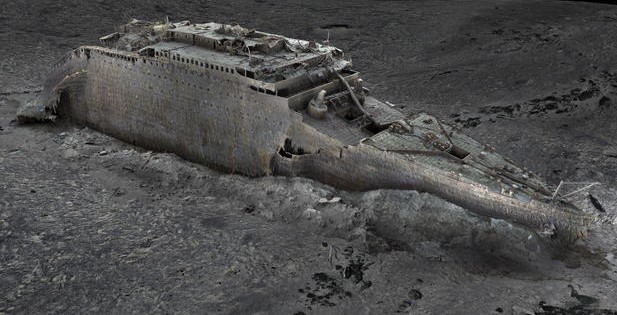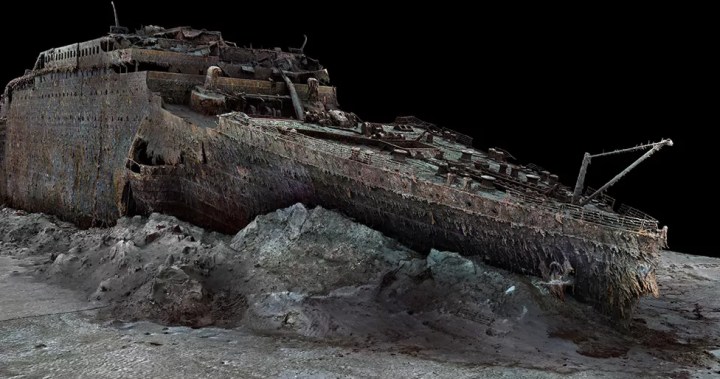A revolutionary digital scan of the Titanic is providing new insights into the doomed ocean liner’s final moments, showing how the ship ripped in two and sank to the ocean floor.
The first-ever full-sized 3D scan of the Titanic wreck, captured by deep-sea mapping company Magellan in partnership with Atlantic Productions, reveals remarkable new details about the ship’s structure and the damage it incurred when it hit an iceberg in the Atlantic Ocean and began to take on water.
The digital scans reveal a new view of the boiler room where the ship split in two, showing some of the boilers as concave, which suggests they were still operating as they plunged into the frigid water.
The scan of the Titanic was carried out in 2022 by Magellan Ltd., a deep-sea mapping company, in partnership with Atlantic Productions.
Magellan / Atlantic Producitons
A detailed computer simulation accompanying the scan also shows that the iceberg didn’t create massive gashes but rather a series of small punctures — each about the size of an A4 sheet of paper. The punctures were spread across six watertight compartments, while the Titanic was only designed to stay afloat with four compartments flooded.
“Titanic is the last surviving eyewitness to the disaster, and she still has stories to tell,” Titanic analyst Parks Stephenson told the BBC.
“Having a comprehensive view of the entirety of the wreck site is key to understanding what happened here.”
The news comes as the scan was studied for a new documentary by National Geographic and Atlantic Productions called Titanic: The Digital Resurrection. (The documentary premieres Friday on National Geographic and will begin streaming the following day on Disney+.)
“I felt there was something much bigger here that we could get from the Titanic,” Anthony Geffen, the CEO of Atlantic Production, told CBS News in 2023, when the first images from the mapping project were released. “If we could scan it, if we could capture in all its detail … we could find out how it sank and how the different parts of the boat fell apart and we can find a lot of personal stories down there as well.”
The daunting task was a huge success, despite the ship lying 3,800 metres below sea level off the coast of Newfoundland.

Get daily National news
Get the day’s top news, political, economic, and current affairs headlines, delivered to your inbox once a day.
It’s the first full-sized scan of the wreck, which lies in two parts. The bow and stern are approximately 800 metres apart and surrounded by a huge field of debris.
Since the wreck was discovered in 1985, it’s been examined in detail but only through fragmentary snapshots. The quickly deteriorating materials, too, have made examination of the boat tricky.
“What we now have for the historical record is, before it falls apart, literally a record of everything to do with the wreck of the Titanic, which will be around forever,” Geffen told CBS of the “digital twin” scan, accomplished by taking more than 700,000 images of the ship from every angle.
Stephenson told the BBC the new mapping technology is allowing researchers a different way to study the ship and cross-reference their findings with eyewitness reports from survivors of the disaster.
“It’s like a crime scene: you need to see what the evidence is, in the context of where it is,” he told the outlet.
“And having a comprehensive view of the entirety of the wreck site is key to understanding what happened here.”
Researchers say the 3D scans have revealed more about what happened the night the Titanic went under.
Magellan / Atlantic Productions
Trending Now

Pierre Poilievre to face 81 other candidates in Ottawa-area riding

The dire wolf has come out of extinction — kind of
For example, the scan reveals a porthole that was most likely smashed when the ship hit the iceberg — corroborating survivor reports that some people’s cabins began to fill with ice during the collision.
And, on the deck of the stern, a valve is seen in an open position, indicating that steam was still flowing into the electricity generating system when the ship went down. This confirms that engineers on the boat were shovelling coal into the liner’s furnaces to keep the lights on to aid the crew helping to get passengers off the sinking boat.
“They kept the lights and the power working to the end, to give the crew time to launch the lifeboats safely with some light instead of in absolute darkness,” Stephenson said.
“They held the chaos at bay as long as possible, and all of that was symbolized by this open steam valve just sitting there on the stern.”
According to National Geographic, the model is so densely detailed that a video rendering of the scan can be projected to life-size in a warehouse, allowing researchers to “walk alongside it and zoom in and out on individual features.”

The 3D scan was made up of 700,000 photographs captured by submersibles.
Magellan / Atlantic Productions
Because the lower section of the Titanic is sitting in sediment on the ocean floor, there are parts of the damaged boat that will likely never be seen again. Also, Stephenson said, it will take experts years to fully examine and explore all the details of the replica scan.
“She’s only giving her stories to us a little bit at a time,” he said. “Every time, she leaves us wanting for more.”
The Titanic, thought to be unsinkable at the time, hit an iceberg on its maiden voyage from Southampton in the U.K. to New York on April 15, 1912. The tragedy claimed the lives of more than 1,500 people.

More on World
More videos
© 2025 Global News, a division of Corus Entertainment Inc.








